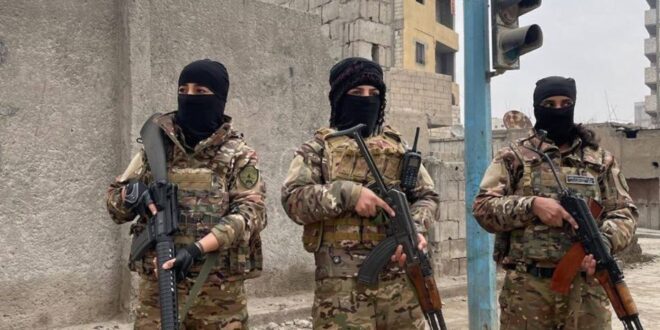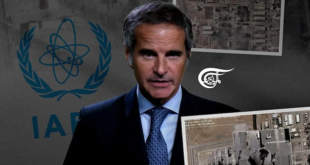The past few days have witnessed a military escalation between the Syrian regime forces and the Syrian Democratic Forces (SDF), which control areas of northeastern Syria.
The clashes that took place in the eastern countryside of Deir Ezzor last week resulted in deaths and injuries. The clashes came with the SDF accusing forces affiliated with the Syrian regime of “attempting to infiltrate towards towns on the eastern bank of the Euphrates River.”
The recent escalation comes after months of clashes between Arab tribes and the SDF, with the latter accusing the regime of supporting them, and although it seems like both parties are losing, each has their reasons to achieve the maximum possible benefit from them.
While the Syrian regime accuses the SDF of controlling Syrian oil and receiving American support, the SDF holds the regime responsible for the attacks its forces have faced in the region.
What are the reasons for the tension?
Since November 2023, the SDF has established military fortifications against the background of its clashes with Arab clans, and in the same month, it clashed with the regime.
There do not seem to be different reasons for today’s escalation, as the clashes do not see a major attack from one side over the other, and seem to remain within the lines drawn between the two parties.
A leader in the Internal Security Forces (Asayish) affiliated with the Autonomous Administration (the political umbrella of the SDF) in the southern sector, said in previous statements to Enab Baladi, that the SDF had repelled several attacks by fighters coming from areas of the Syrian regime in the past few days.
The commander, who withheld his name for security reasons, added that the attacks took place near the towns of al-Shaafa and Abu Hammam in the eastern Deir Ezzor countryside, in addition to a third attack in the town of al-Harmushiyah, coinciding with mortar shelling by the SDF targeting Syrian regime forces positions.
Military affairs researcher at the Jusoor for Studies Center, Rashid Hourani, sees the escalation as the regime’s desire to pressure the SDF, which is targeted by Turkish airstrikes, and the regime implements its escalation against it hoping to force it to make concessions in its favor.
Hourani said in a talk with Enab Baladi, that the regime tries to exploit the pressure on the SDF after the battles fought by the Arab tribes against it, and are still ongoing in some areas in Deir Ezzor.
Despite the escalation between the two parties, it is still within certain rules, which means that the goals are linked to obtaining political gains rather than military gains or controlling geographical areas.
According to Hourani, both parties are in a stalemate; neither the Syrian regime is capable of weakening the SDF at the current stage given the American support, nor the latter is able to confront the regime and the Iranian militias, and the goal of the escalation is to send messages to various parties.
Forces of the Syrian regime are stationed next to the SDF at dozens of military sites in northeastern Syria.
Despite the state of security tension experienced by the banks of the Euphrates River in Deir Ezzor governorate between the SDF and the Syrian regime forces, manifested by shelling, attacks, and armed confrontations, both sides are stationed at joint military points in other governorates such as al-Hasakah and areas of Aleppo countryside.
The city of Tel Rifaat, north of Aleppo, is an example of the intertwining of military forces, where regime forces and the SDF share military checkpoints and points spread along the contact lines with the Turkey-backed Syrian National Army (SNA).
Regime forces also spread along the Syrian-Turkish border in al-Hasakah governorate and in the city of Ain al-Arab east of Aleppo governorate.
Several areas controlled by the SDF witnessed severe security tensions during February, and in addition to clashes with the regime, an attack on February 10 with “RPG” shells and medium weapons on an SDF military point in Dhiban resulted in the killing of two SDF members.
The attack targeted points and headquarters of the SDF in the town of Dhiban and targeted an SDF headquarters in Jabal al-Basira with “RPG” shells without recording casualties or losses.
On the same day, vehicles belonging to the SDF roamed the streets of al-Basira city, and through loudspeakers, elements announced a curfew in the city after targeting its military sites by unknown assailants.
How do both parties benefit from the escalation?
Since September 2023, reciprocal shelling between Syrian regime forces and Iran-backed militias stationed west of the Euphrates River on one side, and the SDF, which controls the east of the river in Deir Ezzor governorate in eastern Syria on the other side, has been recurring.
On October 29, 2023, the SDF said that groups from the Syrian regime and its security apparatus launched an attack with heavy artillery, mortars, and “Dushka” weapons on the villages and towns of Abu Hardoub, Dhiban, and Abu Hammam, resulting in deaths, including civilians.
The SDF responded to the same attack with rocket fire that hit the city of al-Mayadin controlled by Iran-aligned militias, which has been a major center for them for years, resulting in deaths and injuries.
The Russian Sputnik agency reported at the time that a civilian was killed and about 40 others were injured, most of them children and women, due to retaliatory rocket fire by the SDF on the city of al-Mayadin, in response to the success of the Arab tribesmen in “liberating” one of the towns adjacent to an American base in the eastern countryside of Deir Ezzor.
Both parties, the regime and the SDF, enjoy external support, with the latter receiving American support, and there are Iranian militias in the area supporting the Damascus government.
These limited and perhaps studied clashes lead to political benefits for both parties, especially given the nature of these clashes and their geographic extent.
Military analyst Colonel Ahmad Hamada said in a talk to Enab Baladi that he does not see a “real escalation” between the regime and the SDF, but rather these clashes are within an Iranian-Russian desire to control east of the Euphrates within the SDF and the International Coalition’s areas of control.
He added that there are points of tension along the contact lines in the provinces of al-Hasakah and Aleppo and the overlapping areas between them, while there are understandings governing the relationship between these parties in the areas of Manbij, Tel Rifaat, and Qamishli.
He further pointed out that the Russian-mediated negotiations and mediations encounter the desire of the SDF to reap legal gains in managing the east of the Euphrates, which the regime refuses, according to his opinion.
From his side, Hourani believes that the regime and its allies try to pressure the United States considering that the SDF forms the local partner for Washington in the region, and they seek to threaten the American presence and force it to withdraw from Syria.
These tensions coincide with the targeting of American bases in the region, with missiles and drones launched by Iran’s agents from Syria and Iraq accompanying the American bases in both countries, becoming almost daily attacks since mid-October 2023.
 Eurasia Press & News
Eurasia Press & News




